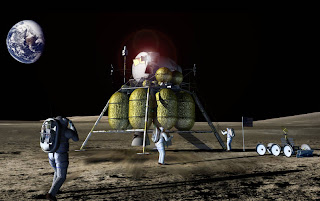
When NASA and 14 space agencies formed the "Global Exploration Strategy and Lunar Architecture," returning to the Moon became a reality. Using important data from the Mars expeditions, future colonization is now more than a possibility.
A planned milestone in NASA’s Vision for Space Exploration was to colonize mysterious Mars, the unfathomable red planet. However, common sense is now saying to return to the Moon first...at least, according to NASA and 1,000 scientists, space advocates, engineers, commercial entrepreneurs and the public.
Over the past year, NASA sent out two questionnaires regarding a return to the Moon. One was entitled “Why should we return to the moon?” and the second was “What do we hope to accomplish through lunar exploration?” NASA reports that the questionnaire responses have led to the development of Global Exploration Strategy and Lunar Architecture---with NASA and 14 global space agencies participating in its venture.
According to NASA’s Science News, plans were made six years ago for a return to the Moon even as Mars was being actively studied. However, both planets have much in common:
• The Moon has no atmosphere – the atmosphere of Mars is relatively thin.
• Mars has only one-third of the Earth’s gravity while the Moon has one-sixth of the Earth’s gravity.
• Both the Moon and Mars are cold: the Moon can be -240 degrees in the shadows while Mars varies from -20 degrees to -100 degrees.
• Both the Moon and Mars are covered with loose “regolith” dust that covers solid rock, with both worlds having layers of regolith 10+ meters deep.
Read more:
A planned milestone in NASA’s Vision for Space Exploration was to colonize mysterious Mars, the unfathomable red planet. However, common sense is now saying to return to the Moon first...at least, according to NASA and 1,000 scientists, space advocates, engineers, commercial entrepreneurs and the public.
Over the past year, NASA sent out two questionnaires regarding a return to the Moon. One was entitled “Why should we return to the moon?” and the second was “What do we hope to accomplish through lunar exploration?” NASA reports that the questionnaire responses have led to the development of Global Exploration Strategy and Lunar Architecture---with NASA and 14 global space agencies participating in its venture.
According to NASA’s Science News, plans were made six years ago for a return to the Moon even as Mars was being actively studied. However, both planets have much in common:
• The Moon has no atmosphere – the atmosphere of Mars is relatively thin.
• Mars has only one-third of the Earth’s gravity while the Moon has one-sixth of the Earth’s gravity.
• Both the Moon and Mars are cold: the Moon can be -240 degrees in the shadows while Mars varies from -20 degrees to -100 degrees.
• Both the Moon and Mars are covered with loose “regolith” dust that covers solid rock, with both worlds having layers of regolith 10+ meters deep.
Read more:
No comments:
Post a Comment